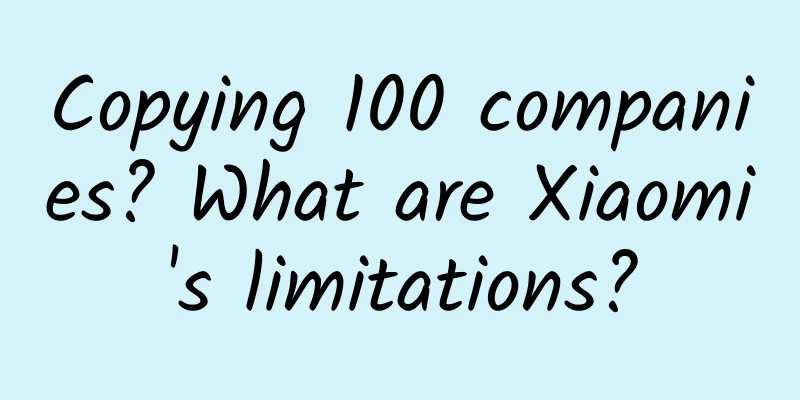Copying 100 companies? What are Xiaomi's limitations?

|
Two and a half years ago, I wrote an article titled " How Xiaomi Survived". At that time, Xiaomi's first generation of mobile phones had been on the market for eight months, and Zhou Hongyi had just launched an attack on Xiaomi on Weibo. In that article, I proposed that Xiaomi was exploring the way for domestic mobile phones, replicating Dell 's direct sales model through the e-commerce front-store and back-factory method. Looking back now, the views of that article are still tenable. Other domestic mobile phone manufacturers have gone through the stages of "disdain to watch" to "not understand" to "follow suit". Huawei , which has been following the most closely , has achieved the best results, while most of those who rely on traditional operator channels have encountered great challenges. In the past two and a half years, some people have asked me to write something else, but because there is not much beyond the scope of my article, I have not started writing. "Focus, extreme, word of mouth, fast" or Internet thinking are actually just new words that have become popular with the rise of the new media of the Internet. The logic of business has never changed. There is nothing new under the sun. After more than four years of development, Xiaomi's current achievements need no further explanation. This road has been paved. Lei Jun is now more confident in speaking, and has begun to propose to replicate 100 Xiaomis through the Xiaomi model. We can also see that in addition to its own mobile phones, TVs and routers, Xiaomi has continuously expanded its related businesses through investment and other means, and has started to make products such as mobile power banks, bracelets, light bulbs, sockets, and air purifiers. At present, Xiaomi's mobile power banks and Xiaomi bracelets have achieved good results. Judging from the current pricing of air purifiers, it can be expected that the results will not be bad. The "Xiaomi model" will soon become a phenomenon, analyzed and discussed by many people. What is the Xiaomi model? According to Lei Jun, the core of Xiaomi's model is threefold: 1. Real materials, good products; 2. Listening to users' opinions, making friends with users, bringing all users in, and working together to make good products; 3. Using Internet technology, e-commerce direct sales, and efficient operations, ultimately making its retail price close to the cost price, so that it can still make money. Lei Jun said that the core is efficiency. However, in my opinion, the core of Xiaomi's model is to use the support of venture capital and the new information medium of the Internet to complete the marketing process reengineering of the traditional manufacturing industry. Whoever understands the Internet and is the first to make good use of it will have a huge first-mover advantage. Efficiency is an incidental attribute of the new tool of the Internet. Venture capital is the key to helping the manufacturing industry rapidly expand its production capacity. Think about the difficulties of traditional manufacturing industries that mostly develop through retained profits. Midea Group has just announced a private placement for Xiaomi, and we can get a glimpse of Xiaomi's financial statements. In 2013, Xiaomi Technology had total assets of 6.45 billion, net assets of 400 million, operating income of 26.6 billion, and net profit of 347 million. With a net asset of 400 million, it leveraged total assets of 6.5 billion and operating income of 26.6 billion, taking the path of low gross profit, high leverage, and high turnover. The Xiaomi model must have several things: 1. Products with decent quality. Because users learn about products through the Internet and pay before receiving them, the product quality cannot be too different from the promotional copy, otherwise it will become as shown in the picture below, which will lead to negative word of mouth, returns and other disputes, and it is not conducive to the secondary spread of word of mouth. If the product is good and the price is low, in the era of such developed social networks, the effect of word of mouth will come, thus forming positive feedback, increasing sales, strengthening the right to speak with suppliers, and further reducing costs. 2. Real price. This is also a necessary element. Since the Internet has helped reduce marketing costs, prices cannot be higher, otherwise others can copy the back door in the same way and at a lower price. Xiaomi has achieved the ultimate in this regard, basically pricing close to cost. In the later stage, as Moore's Law reduces costs and anchors prices, profits can be generated. As for other products that cannot rely on Moore's Law to significantly reduce costs, they mainly rely on large-scale production to reduce costs. If the volume is large enough, occupying upstream and downstream funds can also reduce financial costs. 3. A product launch conference that is loud and widely disseminated, through which the characteristics and selling points of the product are implanted into the minds of the audience. It is not necessary to cover everything, but there must be a few points that are memorable and easy to spread, and then combined with copywriting, fermented and amplified through social media. An opinion leader is a must. Being able to continuously build momentum for your products through speeches and other activities, and making many information channels willing to spread it, is itself a kind of productivity. Many manufacturing companies can make the same products, but lack such marketing potential. There are also many big guys who have such marketing potential, but they focus their main energy on improving their personal influence and fail to provide much help for the company's products. This whole model relies on the development of China's manufacturing industry over the past 30 years. China already has relatively good manufacturing plants that can produce good products, but it is too difficult to reach consumers due to the difficulty of channel construction (think of the high real estate rent) and the huge marketing costs (think of China's regulated media resources). In recent years, the development of e-commerce has made people accustomed to online shopping, and the development of the express delivery industry has also saved logistics costs. The cost of products reaching customers has been greatly reduced compared to 10 years ago. The development of the Internet has also greatly reduced marketing costs. Whoever understands the psychological characteristics of young people and uses the Internet for marketing can achieve better development. Another point that must be emphasized is the venture capital that Internet companies all rely on. Through venture capital, it is equivalent to directly introducing the most adventurous part of the capital in the Western capitalist system, which can rapidly expand production capacity without relying on retained profits to roll over year after year. Of course, some people will say that the domestic capital market can also provide financing for manufacturing companies, but considering the long financing approval cycle of A-shares and the infamy of being accused of "raising money", this is far worse than venture capital investing once a year. Let's take a brief look back at history. When televisions were just becoming popular, Kennedy was the first to use live television press conferences to build momentum and was able to enter the White House. When the Internet became popular, Obama was the first to abandon traditional public funding and use the Internet to raise funds and was also able to enter the White House. Whoever is the first to make good use of advanced tools will be able to dominate. Scope of application of Xiaomi model Lei Jun said that the Xiaomi model can be replicated and he plans to invest in 100 companies with the Xiaomi model. We can discuss which products are suitable for the Xiaomi model. First of all, the product must be a mass consumer product. Only mass consumer products can have a wide audience, which is the basis of sales. At the same time, this kind of consumer product must be homogeneous. Whether it is a mobile power bank, a bracelet, or an air purifier, they are all homogeneous products that everyone can have. This is different from shirts and shoes, which are personalized consumer products. If they are all the same, no one will like them. This is also the situation that Vancl has to face. Different industries have different rules of the game. For industrial products, scale determines the advantage. Only homogeneous products that can be produced on a large scale can build a moat. Secondly, the previous market price of this product was much higher than the cost price of raw materials. The previous market prices of mobile power banks, wristbands, and air purifiers were very high, because in addition to the cost of raw materials, these products also have to bear labor costs, marketing costs, etc., which will be very high when the initial volume is not large. Such products allow low-price strategies to operate. These companies in the Xiaomi model have obtained large sums of money through Internet venture capital, and directly make plans based on the shipment volume of large shipments, and push them to the market at the cost of raw materials, which crushes other brands. After obtaining a large number of orders, the cost is reduced, forming a positive cycle. The mobile power market was in chaos before, and the prices were also very high. Once the Xiaomi mobile power bank was released, it put a lot of price pressure on many mobile power banks. This is even more true in the wristband market. Originally, the wristband is a dispensable thing. If the price is still very high, even fewer people will accept it. According to the price acceptable to the public, it is a one-step process. There may be losses in the early stage, but later through mass production and Moore's Law to reduce costs, it can still be profitable. Third, the product must be easy to deliver. So far, the main commodities of e-commerce are still products that are easy to deliver and do not require much after-sales installation. The courier is only responsible for delivery. Products that do not require subsequent installation services can maximize the advantages of existing e-commerce logistics. Other commodities are much more difficult. Last year, Lei Jun made a bet with Dong Mingzhu. Some people said that Lei Jun should make air conditioners, but a large part of air conditioners depends on subsequent installation. This is a heavy asset offline job. Even if Lei Jun makes air conditioners himself, this part of the cost cannot be saved. If this part of the cost cannot be saved, the price cannot be lowered. By the way, this is also the ceiling that e-commerce companies have to face. So Alibaba will cooperate with Haier's RRS. Fourth, there is no strong brand for the product at present. Whether it is a mobile power bank, a bracelet, or an air purifier, they all belong to a relatively new market. In this market, there is no strong brand that has become very big and recognized by the majority of users. Only such products can rapidly expand their influence and seize the market with the help of Xiaomi's marketing potential. Mobile phones are a little different, mainly because the mobile phone industry is in a revolutionary period due to the development of smart phones, and all brands are adjusting to adapt to the new gameplay in the era of smart phones. This is a strategic opportunity period, which will be gone after it passes, and Lei Jun just caught it, which of course is inseparable from his diligence over the years. The emergence of Redmi has crushed the copycats, which is also related to the fact that the copycat market had a large capacity before, but there were no strong brands. Another point is that the product has a certain electronic interaction function. This is not necessary, but it is related to Xiaomi's main business. If there is no electronic interaction, it cannot interact with Xiaomi mobile phones, etc., it will be an information island. Such a product is not very innovative and does not conform to Lei Jun's strategy of expanding Xiaomi's moat through the interaction between peripheral products and Xiaomi. Limitations of the Xiaomi model From the previous analysis, we can see that the Xiaomi model is applicable to a limited range of products. For products like air conditioners, it is difficult for the Xiaomi model to create a hit product, so now there is news of cooperation between Xiaomi and Midea. Of course, we are not sure how Xiaomi and Midea will cooperate. Midea has air conditioners, refrigerators, washing machines, and other small appliances, with a full range of categories, which is quite in line with Lei Jun's smart home approach. It is quite imaginative to achieve the interconnection of home appliances through interaction with Xiaomi mobile phone routers. The risks of the Xiaomi model are real. One is that it has very high requirements for product quality. If a product is found to have defects after it is shipped, it will have disastrous consequences. Another is that it has very high requirements for sales. The core of the Xiaomi model is that sales can grow rapidly and break through the break-even point. If the product cannot be detonated, there is basically no second chance, and whether a product can be detonated quickly is really an unknown thing. So far, Xiaomi has basically been integrating copycat products in the existing product market and harvesting separatist forces through brand potential. Another thing worth noting is that as the Xiaomi model spreads, more and more categories will dilute the brand effect. And because of the linkage effect of the Xiaomi brand, if one prospers, all prosper, and if one suffers, all suffer. If there is a problem with the quality of a product, it may affect the sales of other products, so it is necessary to check. I wish the Xiaomi model success and we will continue to observe. As a winner of Toutiao's Qingyun Plan and Baijiahao's Bai+ Plan, the 2019 Baidu Digital Author of the Year, the Baijiahao's Most Popular Author in the Technology Field, the 2019 Sogou Technology and Culture Author, and the 2021 Baijiahao Quarterly Influential Creator, he has won many awards, including the 2013 Sohu Best Industry Media Person, the 2015 China New Media Entrepreneurship Competition Beijing Third Place, the 2015 Guangmang Experience Award, the 2015 China New Media Entrepreneurship Competition Finals Third Place, and the 2018 Baidu Dynamic Annual Powerful Celebrity. |
<<: Who will be Bezos' successor? The three executives have obvious advantages
Recommend
A new wave of cold air is coming! Are you ready to keep warm?
Once it gets cold Everyone tried every possible w...
Newbies can earn more than 10,000 yuan a month with this niche blue ocean lucrative project
There are many popular products on every platform...
3-step analysis | The user growth system behind Xiaohongshu’s massive content
High-quality product content is inseparable from ...
Huang Yongsheng's resume: website promotion and marketing skills
Website promotion and marketing of pharmacies 1. ...
A famous female star revealed that she suffers from an "incurable disease"! Doctors warn that this disease is easily misdiagnosed and will recur repeatedly
In recent days, the singer Penny Tai, who has not...
Experts recommend: Complete flu vaccination before the end of October! Because...
On September 6, 2024, at the press conference on ...
Tibetan Fox: I'm so square! I did it on purpose
The Tibetan fox , with its confused and world-wea...
Geely Borui GE New Energy officially launched, starting at 136,800 yuan
As we all know, our country is now vigorously dev...
Can kelp be used to make pork rib soup? It's too small! It can also "capture" carbon dioxide!
Humans have never stopped exploring the ocean. Ho...
After reading this, iOS fonts won’t be that difficult!
[[145301]] The motivation for writing this articl...
Artificial Intelligence Threat Theory: What Are We Really Afraid of?
The man-machine Go battle finally came to an end ...
Satellite image of the China-Laos Railway: How this "mountain and river miracle" was built
On December 3, the China-Laos Railway was fully o...
User operation: user growth under growth hacker thinking
The e-commerce track is about innovation and iter...
Do animals know their fate in advance?
© Brad Wilson Leviathan Press: At the beginning o...
Hands-on experience of ROCK smart business card case, a business and social tool
Every time I attend a meeting or a party, I alway...









